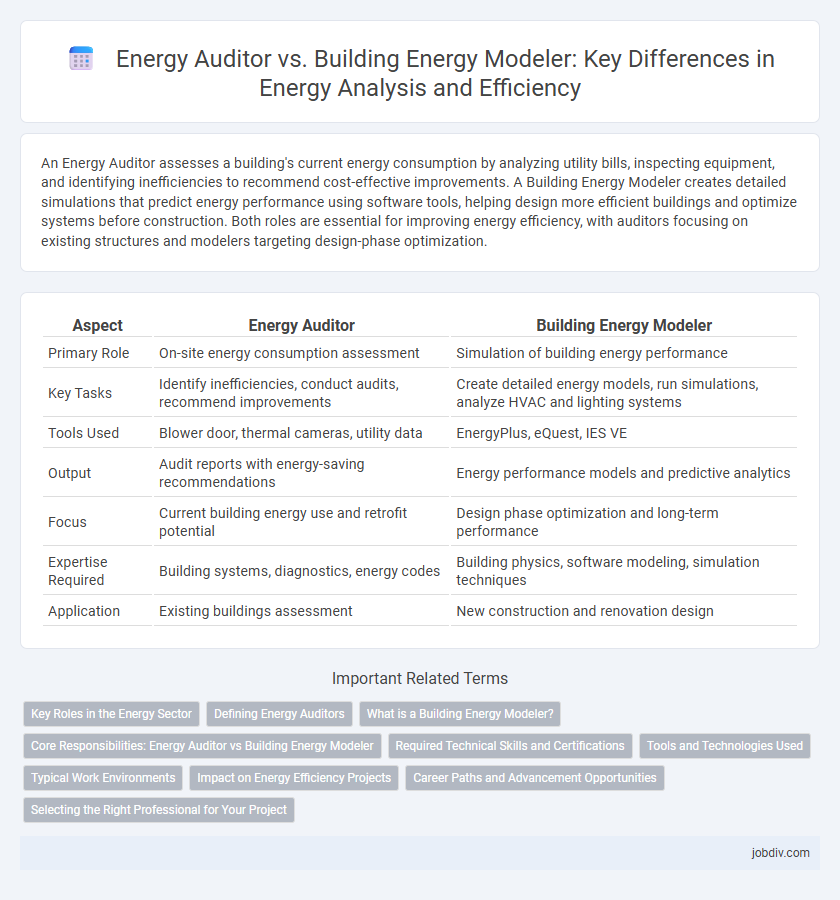An Energy Auditor assesses a building's current energy consumption by analyzing utility bills, inspecting equipment, and identifying inefficiencies to recommend cost-effective improvements. A Building Energy Modeler creates detailed simulations that predict energy performance using software tools, helping design more efficient buildings and optimize systems before construction. Both roles are essential for improving energy efficiency, with auditors focusing on existing structures and modelers targeting design-phase optimization.
Table of Comparison
| Aspect | Energy Auditor | Building Energy Modeler |
|---|---|---|
| Primary Role | On-site energy consumption assessment | Simulation of building energy performance |
| Key Tasks | Identify inefficiencies, conduct audits, recommend improvements | Create detailed energy models, run simulations, analyze HVAC and lighting systems |
| Tools Used | Blower door, thermal cameras, utility data | EnergyPlus, eQuest, IES VE |
| Output | Audit reports with energy-saving recommendations | Energy performance models and predictive analytics |
| Focus | Current building energy use and retrofit potential | Design phase optimization and long-term performance |
| Expertise Required | Building systems, diagnostics, energy codes | Building physics, software modeling, simulation techniques |
| Application | Existing buildings assessment | New construction and renovation design |
Key Roles in the Energy Sector
Energy auditors assess building energy consumption by performing on-site inspections and analyzing utility data to identify efficiency improvements and cost-saving opportunities. Building energy modelers develop detailed simulations using specialized software to predict energy performance, helping architects and engineers optimize design for sustainability and compliance with energy codes. Both roles are crucial in reducing carbon emissions and promoting energy-efficient buildings within the energy sector.
Defining Energy Auditors
Energy auditors specialize in assessing a building's actual energy consumption by conducting on-site inspections, analyzing utility bills, and identifying inefficiencies in HVAC systems, lighting, and insulation. These professionals use tools such as blower doors, infrared cameras, and data loggers to evaluate real-world energy performance and recommend cost-effective improvements. Their primary goal is to provide actionable insights that help reduce energy usage, lower costs, and enhance building sustainability.
What is a Building Energy Modeler?
A Building Energy Modeler specializes in creating detailed simulations of a building's energy consumption using software tools to analyze heating, cooling, lighting, and ventilation systems. This role requires expertise in thermal dynamics, building physics, and energy efficiency standards to optimize design and predict energy performance. Their work supports architects, engineers, and energy auditors by providing accurate models to drive sustainable building strategies and reduce operational costs.
Core Responsibilities: Energy Auditor vs Building Energy Modeler
Energy Auditors focus on assessing existing building energy use by conducting site inspections, analyzing utility bills, and identifying inefficiencies to recommend cost-effective energy-saving measures. Building Energy Modelers create detailed computer simulations of building energy consumption using software like EnergyPlus or eQUEST to predict performance under various scenarios and support design optimization. Both roles aim to enhance energy efficiency, with auditors emphasizing real-world diagnostics and modelers concentrating on virtual performance forecasting.
Required Technical Skills and Certifications
Energy auditors require expertise in energy management systems, proficiency with diagnostic tools such as blower doors and thermal imaging cameras, and certifications like Certified Energy Auditor (CEA) or Building Energy Assessment Professional (BEAP). Building energy modelers must have advanced skills in simulation software such as EnergyPlus, eQUEST, or IES VE, alongside knowledge of building physics and HVAC systems, and certifications including Certified Energy Manager (CEM) or ASHRAE Building Energy Modeling Professional. Both roles demand strong analytical capabilities but differ in the technical focus--auditors emphasize on-site diagnostics and assessments, while modelers concentrate on virtual performance forecasting and optimization.
Tools and Technologies Used
Energy Auditors utilize handheld devices such as blower doors, thermal cameras, and data loggers to assess building performance, alongside software like RETScreen and eQUEST for energy analysis. Building Energy Modelers rely heavily on simulation tools such as EnergyPlus, IES VE, and OpenStudio to create detailed virtual models that predict energy consumption and optimize building design. Both professionals integrate Building Information Modeling (BIM) platforms to enhance precision and streamline data management in energy assessments.
Typical Work Environments
Energy auditors typically operate on-site within commercial, residential, or industrial buildings to assess energy consumption and identify efficiency improvements. Building energy modelers primarily work in office settings, using specialized software to simulate energy performance and predict the impact of design changes. Both roles often collaborate with engineers and facilities managers but differ in their focus on physical inspections versus virtual simulations.
Impact on Energy Efficiency Projects
Energy auditors analyze existing energy consumption patterns and identify inefficiencies through on-site inspections and data analysis, directly influencing cost-saving measures and retrofitting decisions. Building energy modelers create detailed simulations of building performance using software like EnergyPlus or eQUEST to predict energy usage under various scenarios, enabling optimized system design and improved energy savings. Both roles are critical, with auditors providing actionable insights for immediate improvements and modelers supporting long-term, data-driven energy efficiency planning.
Career Paths and Advancement Opportunities
Energy auditors focus on assessing energy consumption and identifying efficiency improvements in buildings, offering career advancement through technical certification and specialization in auditing standards. Building energy modelers develop simulation models to predict energy use, enabling progression into advanced roles in energy engineering and sustainable design consulting. Both career paths provide opportunities in government agencies, consulting firms, and utilities, with increasing demand driven by sustainability goals and regulatory compliance.
Selecting the Right Professional for Your Project
Choosing between an Energy Auditor and a Building Energy Modeler depends on your project's goals; Energy Auditors specialize in on-site inspections and identifying real-time inefficiencies, while Building Energy Modelers use simulation software to predict and optimize long-term energy performance. Projects seeking immediate, actionable insights benefit from an Energy Auditor's expertise in diagnostics and utility analysis, whereas complex design or retrofit projects require a Building Energy Modeler's ability to simulate various scenarios and guide sustainable decision-making. Understanding the distinct roles ensures effective resource allocation and maximizes energy savings over a building's lifecycle.
Energy Auditor vs Building Energy Modeler Infographic

 jobdiv.com
jobdiv.com